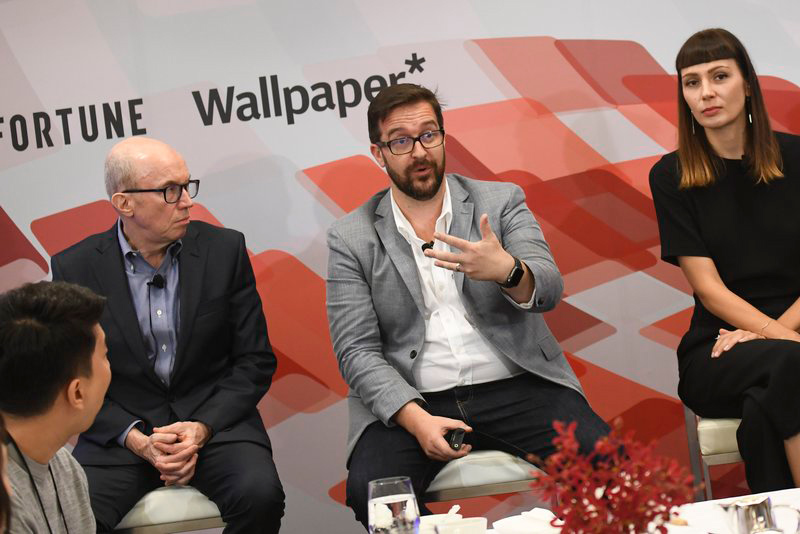
|
麥肯錫設(shè)計(jì)指數(shù)是一個(gè)對設(shè)計(jì)的商業(yè)價(jià)值進(jìn)行量化的指標(biāo),。在該指數(shù)中得分最高的那些公司,其業(yè)績表現(xiàn)要比行業(yè)基準(zhǔn)增長率高出一倍,。不過,,你怎樣才能準(zhǔn)確地衡量設(shè)計(jì)?好的設(shè)計(jì)究竟是一個(gè)可量化的業(yè)務(wù)指標(biāo),,還是“妙手偶然得”,?企業(yè)怎樣才能將設(shè)計(jì)師和設(shè)計(jì)思維大規(guī)模地整合到企業(yè)中?
3月初,,由《財(cái)富》雜志主辦的“頭腦風(fēng)暴設(shè)計(jì)峰會(huì)”在新加坡召開,,會(huì)議吸引了很多產(chǎn)品設(shè)計(jì)師、設(shè)計(jì)顧問,、戰(zhàn)略師和企業(yè)家參加,。會(huì)上,《財(cái)富》雜志的CEO穆瑞瀾向麥肯錫的幾位設(shè)計(jì)專家提出了這些具有挑戰(zhàn)性的問題,。與會(huì)專家包括麥肯錫的合伙人羅德·法默,、馬特·杜拉克,以及該公司的體驗(yàn)設(shè)計(jì)總監(jiān)金姆·穆勒,。
法默首先解釋了“規(guī)?!币辉~在設(shè)計(jì)語境下的含義。他表示,,設(shè)計(jì)的規(guī)?;侵浮皹?gòu)造讓企業(yè)能以統(tǒng)一和可持續(xù)的方式,在更大的范圍內(nèi)進(jìn)行設(shè)計(jì)的能力”,。他還表示,,對設(shè)計(jì)的成果進(jìn)行量化,特別是量化它對企業(yè)業(yè)績的影響,,是實(shí)現(xiàn)這個(gè)目標(biāo)的唯一途徑,。
杜拉克表示,企業(yè)增長的一個(gè)關(guān)鍵時(shí)刻,,就是“當(dāng)創(chuàng)始人終于開始劃分職責(zé),,將部分工作分配給其他人的時(shí)候”。這時(shí),,規(guī)?;陀锌赡艹蔀橐环N必然。
在麥肯錫的專家介紹了衡量設(shè)計(jì)的效率的各種方法之后,,觀眾們也在提問環(huán)節(jié)中向?qū)<姨岢隽艘恍┳约旱钠髽I(yè)遇到的問題,。在這個(gè)環(huán)節(jié)中,專家們再次探討了設(shè)計(jì)的定義,,并表示企業(yè)必須將一名訓(xùn)練有素的設(shè)計(jì)師的設(shè)計(jì)能力與設(shè)計(jì)思維在不同業(yè)務(wù)領(lǐng)域的應(yīng)用區(qū)分開來,。
為了說明企業(yè)可以如何利用設(shè)計(jì)型思維實(shí)現(xiàn)規(guī)模化,,穆勒舉了一個(gè)披薩零售商的例子,。這家披薩公司面臨著來自于快遞領(lǐng)域的創(chuàng)業(yè)公司的激烈競爭,這時(shí)麥肯錫的一個(gè)小團(tuán)隊(duì)加入了進(jìn)來,。五個(gè)星期后,,他們開發(fā)了一種最小規(guī)模的產(chǎn)品——它雖然個(gè)頭最小,但依然能給顧客帶來價(jià)值,。他們給它取名叫“當(dāng)日披薩”,。
首先,這家公司向一家商店的10%的顧客提供了這種最小份的披薩,,然后慢慢地解決產(chǎn)品初步推出后發(fā)現(xiàn)的問題,。(比如他們還對披薩的照片進(jìn)行了A/B測試,最后決定重新拍攝公司使用的所有披薩圖片,。)穆勒表示:“就這樣一步步地,,我們知道了我們需要的究竟是什么?!?/p>
不過,,法默也提醒觀眾,規(guī)?;皇沁_(dá)到目的的一種手段,。“你要非常清楚你的戰(zhàn)略意圖。你為什么要擴(kuò)大規(guī)模,?清楚這一點(diǎn),,你就會(huì)得更多的成功?!保ㄘ?cái)富中文網(wǎng)) 譯者:樸成奎 |
Companies with top scores in the McKinsey Design Index, which quantifies the business value of design, outperformed industry-benchmark growth by as much as two to one. But how exactly do you measure design? Is good design a quantifiable business metric, or is it something more serendipitous? How can businesses successfully integrate designers and design thinking into their organizations at scale?
These challenging questions were put to a panel of design experts from the global consulting firm McKinsey & Company by Fortune chief executive Alan Murray and an engaged audience of product designers, design consultants, strategists, and business owners. The session took place last Wednesday at Fortune’s Brainstorm Design conference in Singapore; McKinsey associate partners Rod Farmer and Matt Durack were joined by the firm’s experience design director, Kim Müller.
Farmer kicked off the conversation by explaining what scale actually means in this sense: “To build capabilities that enables an organization to design at a larger extent in a uniform and sustainable way.” He also went on to explain how quantifiable impact—actually measuring the impact on the bottom line—is the only way to achieve this.
The key moment for growing companies is “when the founder finally has to split roles and delegate parts of their job to other people,” Durack said. That’s when scale has the potential to become a liability.
After a quick dive into the various methods that McKinsey recommend for measuring the effectiveness of design, the audience were asked to put their own business problems to the panel. The discussion then moved on to the definition of design and a need to separate the craft of a trained designer from the application of design thinking across different business disciplines.
To give a practical example of what scaling a business using design-led thinking, Müller explained a recent project working with a pizza retailer. The pizza firm was struggling in the face of competition from delivery startups, so a small team from McKinsey went in. After five weeks, the group developed a minimum viable product—the smallest thing they could build that delivers customer value—called Pizza of the Day.
The retailer launched the offer to 10% of customers connected to one store, then slowly honed the issues with that initial offer. (An example: They conducted A/B testing on photos of pizza and decided to reshoot all of the pizza imagery used by the business.) “By going step-by-step, we knew what we needed,” Müller said.
But scale is a means to an end, Farmer reminded his audience. “Be very clear about your strategic intent,” he said. “Why do you want to scale? Be very clear about that, and you’ll have a lot more success.” |






